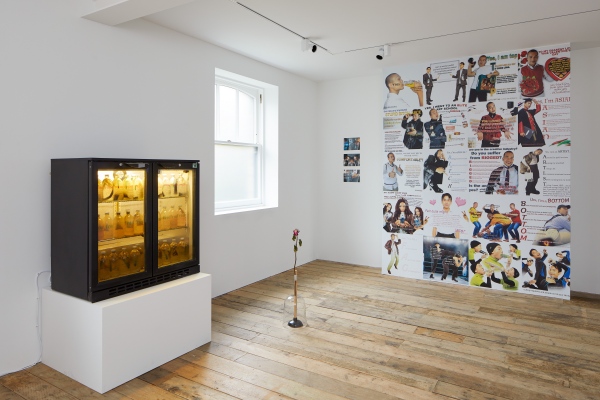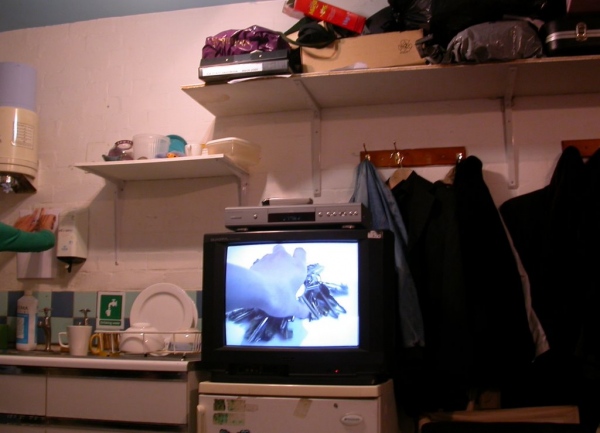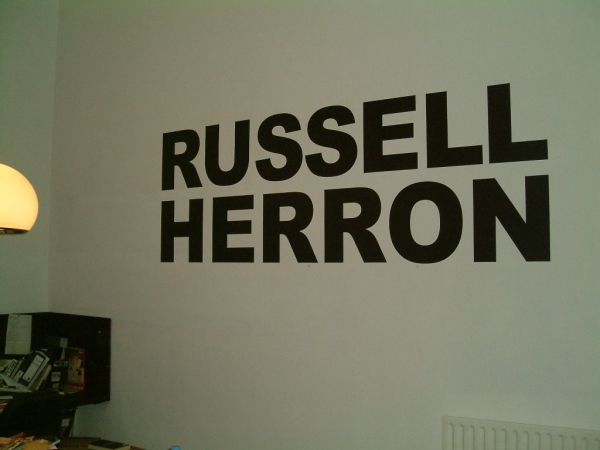
Working Progress, installation view at the South London Gallery, 2020. Photo: Andy Stagg

Lena Nix, Visible/Invisible (2006), Private: Staff Only, Institute of Contemporary Art, 2006

Russell Herron, Russell Herron (2006), Private: Staff Only, Institute of Contemporary Art, 2006
Published: Art Monthly, September 2020
Staff Shows
Precarity doesn’t refer to a unified class. As Gerald Raunig writes in A Thousand Machines from 2008, there are different severities, it’s ‘“rigidly repressive” for refugees but more “smooth” for “creative classes”’; normal, relatively frictionless but still not OK. Compared to other exhibitions, for instance, staff shows, for want of a better term, tend to have a short turnaround and receive little gallery promotion, perhaps because institutions are uneasy about staking their reputations on shows which have not been developed under the full control of in-house curators and gallery management. Accompanying interpretive texts and photographic documentation are also often limited, not readily accessible or non-existent. Minimal promotion not only means staff shows most likely receive small numbers of visitors when they are open to the public, but in the absence of archiving, it also means that we can’t be sure how often they are happening. Why, then, put the shows on at all?
I became aware of this type of show in Summer 2019 when I heard about a staff show at London’s Institute of Contemporary Art. I later visited one at the South London Gallery and have since found records of a handful of past examples. This article’s necessarily limited claims are specific to those case studies and by no means universal to all staff shows, but I hope provide a starting point for further discussion and research.
Staff shows are generally not listed, previewed or reviewed not only because they are not heavily promoted by galleries, but also because they are often not open to outside viewers then publications don’t consider the exhibitions to be of public interest. The lack of coverage in turn devalues staff shows and discourages future engagement. Even the term, ‘staff show’, diminishes their importance: the prefix ‘staff’ marginalises the exhibitors, while ‘show’ implies something less artistically complex or significant than an ‘exhibition’, designed more to entertain than to inform, to arouse fleeting excitement as opposed to thoughtful reflection. Still, the term is useful because it distinguishes staff shows from other types of exhibition and the very particular context in which they are produced.
Co-curated by Russell Herron and Joseph Schneider, ‘Private: Staff Only’ (1 September – 31 October 2006) featured the work of more than 70 ICA staff. Closed to the public, it was displayed entirely in private spaces, only accessible to employees: the back stairs of the gallery, a trade lift, the kitchen, front-of-house staff room and communications office. Schneider worked front of house, while Herron managed the bookshop. On a blogpage made for the show, which includes images and descriptions of the work, Schneider writes ‘I love working at the ICA … I love the people I work with’. He says it has been ‘thought-provoking’, ’inspiring’, ‘a real education’. The job allowed him to continue making art and, he adds, the hours were flexible. ‘However, I still want to escape. I have spent too many long hours sitting in the gallery projecting my own work into the space … Fighting the boredom ... making surreptitious notes … describing ... possible ways out.’ The desire to organise the show came out of desperation: ‘Desperate to show and desperate not to remain hidden … Desperate because I work in a job that doesn’t pay very much. Desperate because I have worked at it for too long.’
Like other staff shows, ‘Private’ developed out of the artists’ struggle to display their own work and the financial insecurity of entry-level gallery work. Artists’ opportunities to exhibit are largely dependent on obtaining institutional recognition (academic qualifications, grants and awards, gallery commissions and residencies, press coverage and critical appraisal etc), but artists in staff shows are often not at developed stages of their careers, many are still studying, some are recent graduates. Others may have left art college or university long-since or may never have studied art. Though they may regularly make work and occasionally feature in gallery shows, they are otherwise yet to gain widespread institutional validation, which makes it difficult to find chances to exhibit.
Whereas organisers may occupy administrative, supervisory or mid-management positions, exhibitors in staff shows tend to work in entry level, front-of-house jobs (invigilators, shop assistants, baristas etc), which can be deeply unfulfilling, dull, sometimes demeaning – and precarious. Wages are low and stagnant, usually minimum or living wage, and saving is hard; full-time jobs are broken up into a series part-time roles, reflected in the inflated number of exhibitors involved in staff shows; casual working hours makes planning ahead difficult; there is little potential for skill-development and career progression, and meagre workplace benefits. At the same time, the huge demand for FoH work means staff members are highly replaceable. The lack of job security has been brought into sharp relief by the effects of the coronavirus. Many gallery closure announcements have been strategically unclear about whether commitments to continue paying ‘all staff’ include agency workers and contracted employees who can’t work remotely, like FoH, security, cleaners etc. (Of course, artists who exhibit in non-staff shows also suffer from precarity, even apparently well-established artists often have to work part-time jobs to make ends meet).
As in the case of the 2006 ICA exhibition, staff shows seem to feature large groups of artists, each often working with disparate subject matter. To paraphrase Hal Foster’s 2009 Artforum essay, ‘Precarious’, the ‘lack of shared meaning, methods, or motivations’ in staff shows reflects artists’ financial instability, their own ‘schismatic condition’. A recent example at the South London Gallery, ‘Working Progress’ (1 March – 26 April 2020), featured 26 artists from the gallery FoH team. Open to the public, it was presented across three galleries in the Fire Station building, offering artists a welcome opportunity to gain public exposure. The title suggests that artists can advance their careers while working at the gallery, but it also implies a prolonged deferral of progress, an acknowledgment that while part-time work provides the financial means to make art, it also takes time and energy away from it. However the title is read, it seems to preface an exploration of gallery work, but unlike the 2006 ICA show, there was no direct, consistent engagement with the subject in the presentation or content of the works, no real reflexive turn, except the coincidence that the staff work in the galleries that their art occupies, and no account given of artists’ motivations for taking part, or their experiences of FoH work. ‘Private’, by contrast, disrupted the gallery’s working conditions and gave voice to the staff’s collective complaints and ambitions (albeit behind closed doors). Organisers took a ‘guerrilla approach’, occupying spaces where before only ‘the boredom of bureaucracy had its home’, wrote then ICA director of exhibitions, Jens Hoffmann, in an essay on the exhibition blogpage. Whereas the SLG artists appeared largely mute curatorially, the exhibition itself seemed to reinforce the gallery hierarchy, reproducing FoH staff’s powerlessness.
Like other staff shows, the main purpose of the SLG’s’ Working Progress’ exhibition was not to examine employees’ experiences of their jobs, but to provide a space for as many artists as possible to display their work. Named after the day it opened, the ICA’s 2019 staff show, ‘Monday’, took place over one day, 19 August, as part of an end-of-summer party between exhibition programmes. Employees could bring plus-ones but otherwise the exhibition was closed to the outside public. The show was installed in vacant galleries, normally occupied in-season. ‘Monday’ was intended as a celebration of staff’s varied practices, featuring young artists in part-time study, some who went to art school 30 years ago and others who had never previously considered displaying their art in public. Many felt comfortable submitting work precisely because it was behind closed doors. The show was an opportunity for participants to share their work without fear of judgement, a chance to present work still in development, test new ideas. It was also a social event, an evening for co-workers to have fun, get to know each other better. While ‘Monday’ didn’t offer artists public recognition, it at least enabled more artists to show work.
Staff shows may be inclusive but they also, sometimes, exploit unpaid labour. Interviews with exhibitors and organisers from the three exhibitions discussed reveal in each case that the artists were not paid a fee for contributing. Plus, organisation and installation work was partly carried out outside contracted hours. Galleries do not force staff to participate, they take part willingly; but, as already mentioned, artists involved in staff shows have limited opportunity to exhibit elsewhere. Additionally, it might be claimed that galleries do not benefit from staff shows, they’re a strain on resources, use up valuable exhibiting space, and distract staff from their contractual responsibilities. Galleries would say that they are put on purely to support staff members’ practices. But, public staff shows, like the SLG’s ‘Working Progress’, not only offer artists public exposure, they also enhance the gallery’s reputational capital because the organisation is seen supporting developing artists, and therefore seen as being progressive and socially conscious. Also, private staff shows motivate the – perhaps demoralised – workforce, strengthen employee bonds and demonstrate that staff are valued by their employers. They are an investment in human resources, like business team-building exercises, expected to produce returns in productivity.
While critical engagement is vital, it is hard to apply critical rigour to a group of artists brought together by shared financial insecurity. Even if you isolate criticism to the institution, you potentially, perhaps inevitably, implicate the artists (ie staff shows are exploitative but the artists are complicit in their own exploitation). The approach assumes an impossible moral externality, a refusal to acknowledge the artists’ situation, the economic necessities of compromise. On the other hand, not to offer artists critical appraisal, to give them blanket praise, not only patronises artists but to turn them into victims. It also risks tacit approval of their precarity and exploitation. The only option left seems to be critical withdrawal.
Critic and curator Irit Rogoff poses a possible solution. In the 2003 essay ‘From Criticism to Critique to Criticality’ (see also Maria Walsh’s ‘Critique Fatique’ in AM400), Rogoff describes a shift in critical register: ‘criticism’, which involves applying value judgements or ‘finding faults’, gave way to ‘critique’, a process of examining an argument’s underlying logic to call out inconsistencies and injustices. But critique, Rogoff says, tries to sustain an impossible critical distance, an ‘external knowingness, an ability to look in from the outside’. In its place, Rogoff proposes ‘criticality’, which tries to occupy both ‘inside’ and ‘outside’, to ‘inhabit’ a problem rather than analyse it from afar. ‘Criticality’, Rogoff adds in her 2006 essay ‘Smuggling – An Embodied Criticality’, comes out of an attempt to recognise that ‘we may be fully armed with … the most sophisticated modes of analysis but we nevertheless are also living out the very conditions we are trying to analyse’.
Critics can’t (and shouldn’t try) to inhabit or embody suffering they have never experienced, but any appraisal of staff shows should be sensitive to the messy conditions out of which they develop. Again, I’m still not advocating pity criticism and condescension. To quote Rogoff, embodied criticality is a ‘double occupation’ – it’s not incompatible with ‘critique’, it still offers the possibility to make value judgements and ‘allocate blames’. Nor is it a softer, nicer, sharp-edges-rounded-off-type-critique, it’s pragmatic, it holds power to account precisely because it doesn’t view problems in the abstract, it calls out galleries’ abuses because it tries to see staff shows from participants’ perspectives. A staff show review would examine the conditions of the works’ making, while at the same time attempt to acknowledge artists’ agency, their potential to create work which shifts between inside and outside the forces of their own precarity, work which reproduces as well as reflexively analyses its ‘schismatic condition’, which somehow tries to share a shared lack of meaning, which exploits the use of the gallery’s platform while challenging its power structures.
Galleries should be held to account but criticism needs to be accompanied by positive suggestion. By allocating permanent funds and spaces to staff shows, galleries could bring audiences a unique source of artistic imagination. If staff shows are to fulfil their as yet unknown potential, they must meet some basic requirements. First, galleries should pay artists and organisers. Second, to permit the widest participation, artists should have the option to exhibit in both public and private shows. Finally, galleries should give organisers the resources to publish and archive exhibition interpretation and documentation, not only for public reference, but to also ensure that participants can draw upon the records to gain future commissions.